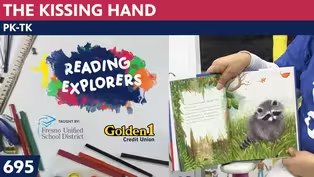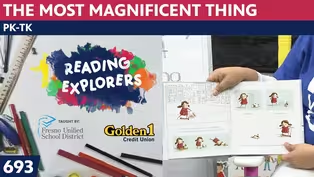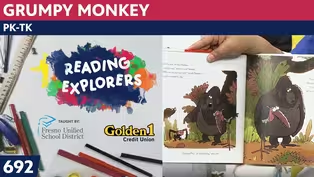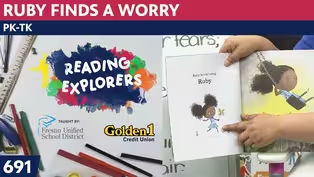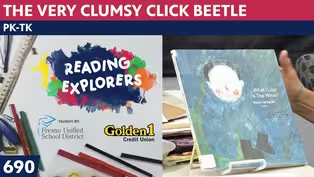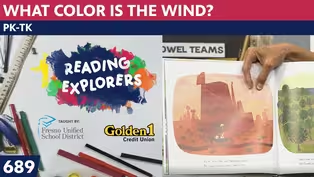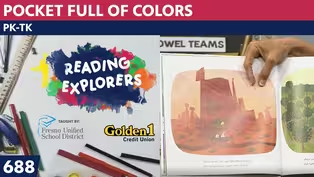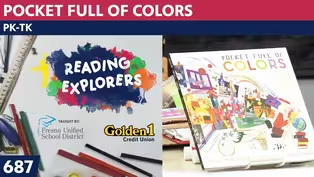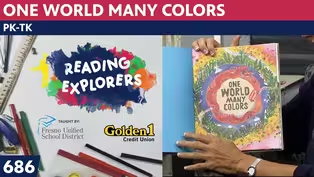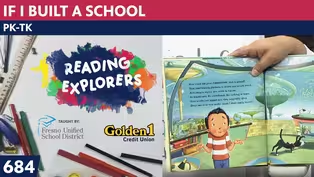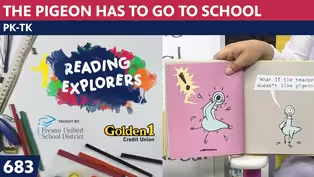
TK-316: Henri Matisse
Season 3 Episode 72 | 14m 14sVideo has Closed Captions
Join Mrs. Readwright at Camp Discovery!
Transitional Kindergarten teacher, Mrs. Readwright, welcomes students back to Camp Discovery, a fun learning space packed with reading adventures & fun games!
Problems playing video? | Closed Captioning Feedback
Problems playing video? | Closed Captioning Feedback
Reading Explorers is a local public television program presented by Valley PBS

TK-316: Henri Matisse
Season 3 Episode 72 | 14m 14sVideo has Closed Captions
Transitional Kindergarten teacher, Mrs. Readwright, welcomes students back to Camp Discovery, a fun learning space packed with reading adventures & fun games!
Problems playing video? | Closed Captioning Feedback
How to Watch Reading Explorers
Reading Explorers is available to stream on pbs.org and the free PBS App, available on iPhone, Apple TV, Android TV, Android smartphones, Amazon Fire TV, Amazon Fire Tablet, Roku, Samsung Smart TV, and Vizio.
Providing Support for PBS.org
Learn Moreabout PBS online sponsorshipMore from This Collection
Valley PBS and Fresno Unified School District have partnered with Golden 1 Credit Union to create Reading Explorers Lessons for grades Pre-Kindergarten through Third grade. The daily lessons will be taught by Fresno Unified School District teachers and are created to help students practice their reading skills and reinforce lessons during distance learning.
Video has Closed Captions
Valley PBS presents Reading Explorers Lessons for Pre-Kindergarten and TK. (26m 27s)
PK-TK-693-The Most Magnificent Thing
Video has Closed Captions
Valley PBS presents Reading Explorers Lessons for Pre-Kindergarten and TK. (26m 26s)
Video has Closed Captions
Valley PBS presents Reading Explorers Lessons for Pre-Kindergarten and TK. (26m 28s)
Video has Closed Captions
Valley PBS presents Reading Explorers Lessons for Pre-Kindergarten and TK. (26m 28s)
PK-TK-690: The Very Clumsy Click Beetle
Video has Closed Captions
Valley PBS presents Reading Explorers Lessons for Pre-Kindergarten and TK. (26m 22s)
PK-TK-689: What Color is the Wind?
Video has Closed Captions
Valley PBS presents Reading Explorers Lessons for Pre-Kindergarten and TK. (26m 21s)
PK-TK-688: Pocket Full of Colors
Video has Closed Captions
Valley PBS presents Reading Explorers Lessons for Pre-Kindergarten and TK. (25m 58s)
PK-TK-687: Dancing Through Fields of Colors
Video has Closed Captions
Valley PBS presents Reading Explorers Lessons for Pre-Kindergarten and TK. (26m 20s)
PK-TK-686: One World Many Colors
Video has Closed Captions
Valley PBS presents Reading Explorers Lessons for Pre-Kindergarten and TK. (27m 13s)
PK-TK-685: School is Wherever I am
Video has Closed Captions
Valley PBS presents Reading Explorers Lessons for Pre-Kindergarten and TK. (26m 32s)
PK-TK-684: If I Built a School
Video has Closed Captions
Valley PBS presents Reading Explorers Lessons for Pre-Kindergarten and TK. (26m 21s)
PK-TK-683: The Pigeon Has to Go to School
Video has Closed Captions
Valley PBS presents Reading Explorers Lessons for Pre-Kindergarten and TK. (26m 22s)
Providing Support for PBS.org
Learn Moreabout PBS online sponsorship(bright music) ♪ Good morning to a brand new day ♪ ♪ Time to learn and games to play ♪ ♪ Learning things is so much fun ♪ ♪ Learning is good for everyone ♪ (bright music) (happy music) - Hello, early learners.
I want to welcome you back to the art room where we are continuing our study from the last week, when we studied all different kinds of snowmen.
We were using this book by Amy and Greg Newbold.
And they have gone through here and chosen artists for us to look at, how they might have painted a snowman.
Let's start our day off with our hello song, and then we will go right into our art.
And the song goes, ♪ Hello nice to see you everyone ♪ ♪ Hello nice to see you everyone ♪ ♪ Hello to you hello to you ♪ ♪ Hello to you hello to me ♪ ♪ Hello everyone nice to see you everyone ♪ All right, I have a few names to call out this week and I'm starting off with Kylie and Kaleena.
Hello, and thank you for watching from your school when you're doing art with your teacher Ms. Damian.
Now last week we studied the art that is behind me and we started out with Keith Haring.
We did a Clint, we did van Gogh.
We studied Yayoi Kusama, and Pablo Picasso.
And today we're going to go back to an old friend of ours, Henri Matisse.
We studied him when we talked about apples and we also studied him when we learned about cut paper.
Now Henri Matisse was a French artist, remember him?
And he started out by painting and he was working with paintings and then he got very ill, and he couldn't stand to paint any longer.
So from his bed, he began to cut paper and his helpers would place it around the wall and he would get it just right.
And then he would glue it down.
Well, we're going to talk about if Matisse, painted a snowman and it goes like this.
♪ If Matisse painted a snowman ♪ ♪ How would that snowman look ♪ ♪ Would he be like his other work ♪ ♪ Let's check out the book ♪ And in the book, is a picture of Matisse's snowman.
And what we're doing is making a collage with just cut paper.
So here is Matisse himself, cutting out paper and preparing to glue it to his artwork.
This is called Sorrow of the King.
And they said this might be sort of a self portrait that he took of himself.
And you can see some figures as this the one that's supposed to be Matisse, or this one playing that guitar is that Matisse?
Let's see what his artwork might be, if we were going to cut a snowman.
I have already prepared for myself, three squares, one big one for the bottom part of his body, a medium sized one for the middle of his body, and a smaller square for the top.
And look how I measure to make sure it fits onto my background.
Even before I cut out any of the round parts.
So, large, medium, small, but I'm looking at it so I can see it.
This is the way you would see it, large, medium, and small.
And the reason I turn it to myself is because it's hard to work upside down, but let's begin.
The reason that I start with the square already cut is because if I'm not very good at cutting out circles, it's easier to start out with the size of a square and just cut off the corners.
And then you can round it off a little bit more, if that works out better for you.
You can see that it's not perfectly round like a circle.
It's more, there are little pieces of them that aren't round, but when you make a snowball this giant, and you start out small and you keep rolling it and getting more and more snow on it, it doesn't really turn out to be perfectly round I don't think.
So I'm going to put this on my paper.
You can use any color background you want.
That's what's nice about doing artwork.
If you are doing it, it's your creation and you can put it on any background you want.
You know if you're an artist and your own expressionist, you might even make your snow a different color.
It doesn't really matter because this is your work remember.
And if anyone tries to tell you it has to be white, you tell them, Oh, here let me give you a piece of paper of your own and you make yours white, and I'm going to make mine this color.
But I like the idea of making a snowman white because in real life, he is a white figure.
And I'm going to put that.
I overlap it a little bit because if you sit it right on top and you don't pack any snow around it, oftentimes you'll lose part of its head.
Remember I'm curving around and just cutting off the corners and cutting off this corner.
I'll go up here and cut off this corner.
All four corners are cut off.
And I will I put glue around the whole edge, so it doesn't pop off.
Now, I can think about what kind of things I want to add to it now.
For me, I think I've told you in the past that I keep all of my scraps because at one point or another I will want to add them to something.
And even the smallest pieces, these probably not.
Although I could make eyeballs later.
I'm just going to set this over and clean it up later.
But let me get into my scrapbooks.
And I have it set up in rainbow order.
I have it set up red, orange, yellow, green, blue, dark blue, purple.
So that when I need something I know exactly what I'm reaching in and getting.
Now if I pull out, this color, what do you think that I'm choosing to do next?
You're right.
I'm going to put his carrot nose.
I brought a carrot for you to guess something from the mystery box, but I thought it's the same three things I brought last time and just different colors.
I brought a red scarf.
I brought a red hat.
I brought the stick that I could use for his arms.
And I brought, a stocking cap.
I'm going to put this big carrot in the middle of his face.
And if you want yours to stand up, just don't glue it all the way down and you want it to pick up if you want it to be a little bit 3D.
Now, I'm going to put my scraps over here.
I like to keep my area clean so that as I'm working, nothing gets in the way.
Now think about on yours.
What would you like to add?
I think I want to put a hat on mine and I think I'd like it to be maybe a green hat.
'Cause I don't have plans from anything else green.
So I don't want everything the same color when I work.
I like it to be different.
Ooh.
This is one of those forest green.
Now look what I'm doing.
I'm putting it up next to his head to think how far away I would need to do it.
And I can use my scissors to snip it or you can say, Oh I'm going to start it right there.
And you just rip up a little piece so that you can say, I want mine to be a stocking cap, and I'm going to make it go out.
And I want a little ball on the end.
So I'm just making it curvy.
Do you notice I'm not drawing mine?
I think that drawing takes so much away from when you just cut it.
But if I look at it and I say, Oh, that is way too big.
So then I can just trim it down.
I don't have to go and draw it again.
And I, because you know I don't think I need to make my art perfect.
I just want it to make it lovely.
Going to make this go around.
So it'll have a little rounded part, and I'm going to glue on his head where I want it to go, and then glue up the top of it.
So that when I put it on here, it will stick.
I might like to have a scarf that would match.
So wouldn't a green scarf be pretty, but maybe I'll make it a light green and make some stripes on it.
Oh, this'll be good.
And I again measure how far it is across there.
And then I can just cut it off.
And I think of the shapes.
People think that it's hard to make things but you just think, Oh, that shape is usually a rectangle kind of shape and just lengthen it out.
Oh, that works out good.
I'm going to put a little glue just where it's going to go onto his neck.
And I will put that under his chinny chin chin.
Later I'll add stripes when I have time.
I think I might have time today but I don't want to leave that like that.
'Cause I still want it to make the twig arms.
Oh, there's a piece of brown paper just sticking out.
Great.
Since I'm going to have two arms, I'm just going to fold my paper in half.
That way I can cut two twigs the same.
So I'm just going straight.
But then I know that the branches kind of go out a little bit and I'm going to make a curve, because it's much easier to cut off of something that is small.
This piece of paper still hooked on it would be hard for me to turn my paper.
So I turn it like that way.
And I go in for a finger, out.
I just cut a V out of it.
I go in for a finger, and out, and I can go in here and I might even, you know how I like to make a thumb.
'Cause when we do our arms, you make the thumb point toward the body.
Now look, I just open it up and I have two arms.
I will put this just to the length that is the arm part and not the hand, and decide which way I'll stick it on the outside here.
Now, if you're going to be carrying this artwork around, you will probably want to glue down all of your parts.
But I'm not going to carry mine around much.
So I don't care if it sticks out because it kind of then looks like a real twig.
I need to put some black eyes like coal.
So I'll bring out a piece of scrap paper.
I'm going to tear it off a little bit because it makes it hard for me to work, if it's a big piece of paper.
And I'm folding it in half because I'm going to make two eyes and I'm making them bumpy like a bumpy rock or bumpy piece of coal.
I found some burnt up branches in a barbecue when I was up at the snow.
And whose birthday was it?
Was a holiday and I went there and I said, Oh good someone left some burnt up wood.
I can make my snowman's eyes.
Ooh, get across.
Ooh, those are big eyes.
I might need to trim them a little bit, but I'll put them on here like this and maybe I'll make a little mouth.
Oh, I like how that looks.
Maybe I'll make a wooden stick mouth.
Boys and girls, if you don't finish yours right now don't you worry because you can finish it later.
I'm just making him have a little twig smile.
Put this up here.
You know I'm going to decorate my scarf.
I might put some buttons on later, but there, here he is.
And it looks like he's got a good face on him.
He just needs to be decorated a little bit.
And you know I always bring my work back to show you.
So let's take a look.
Yeah, he would be a little fancier.
All right.
I want you to know that tomorrow, I'd like you to bring gray paper.
If you have it blue or gray for a background and bring pastels because we're going to do four snowman for Andy Warhol.
All right.
Let's sing our goodbye song and say a little more about Andy Warhol.
♪ Goodbye see you next time everyone ♪ ♪ Goodbye see you next time everyone ♪ ♪ Goodbye to you ♪ ♪ Goodbye to you ♪ ♪ Goodbye to you ♪ ♪ Goodbye to me ♪ ♪ Goodbye see you next time everyone ♪ So Andy Warhol, he's going to be one snowman, two snowman, three snowman, four.
So bring four little pieces of paper and I'll see you tomorrow boys and girls.
Thank you for joining me today.
Bye bye.
(bright music) ♪ Good morning to a brand new day ♪ ♪ Time to learn and games to play ♪ ♪ Learning things is so much fun ♪ ♪ Learning is good for everyone ♪ (bright music)
Support for PBS provided by:
Reading Explorers is a local public television program presented by Valley PBS
